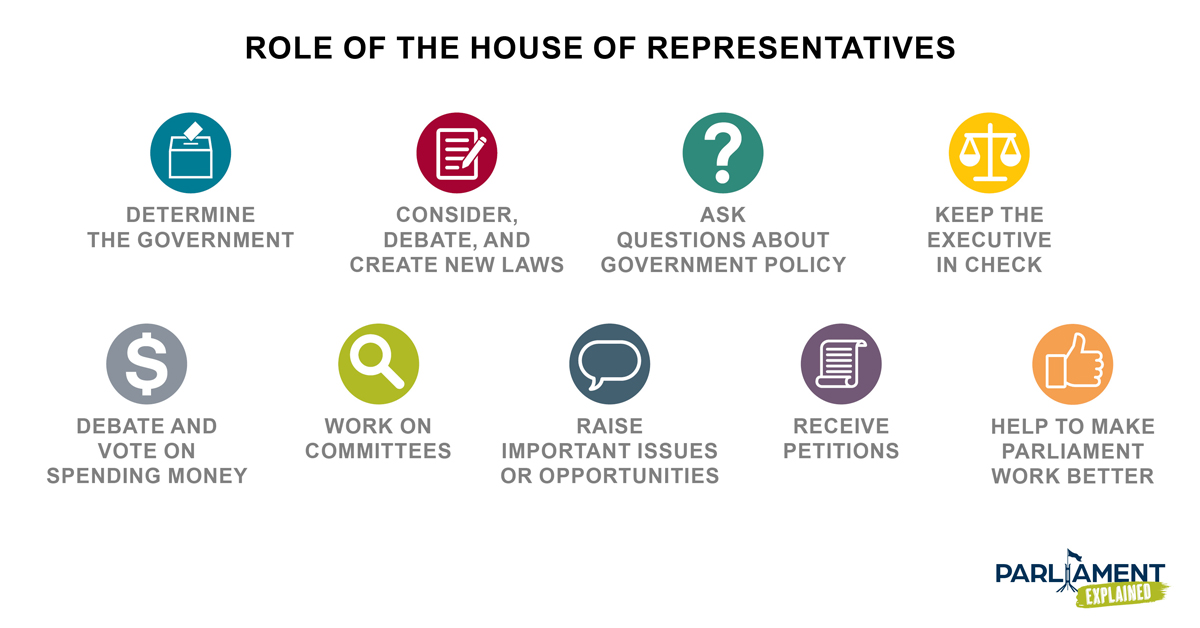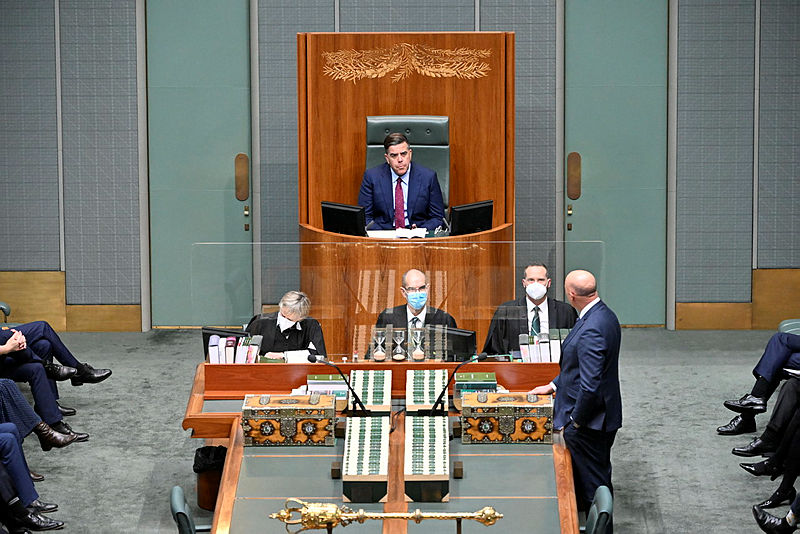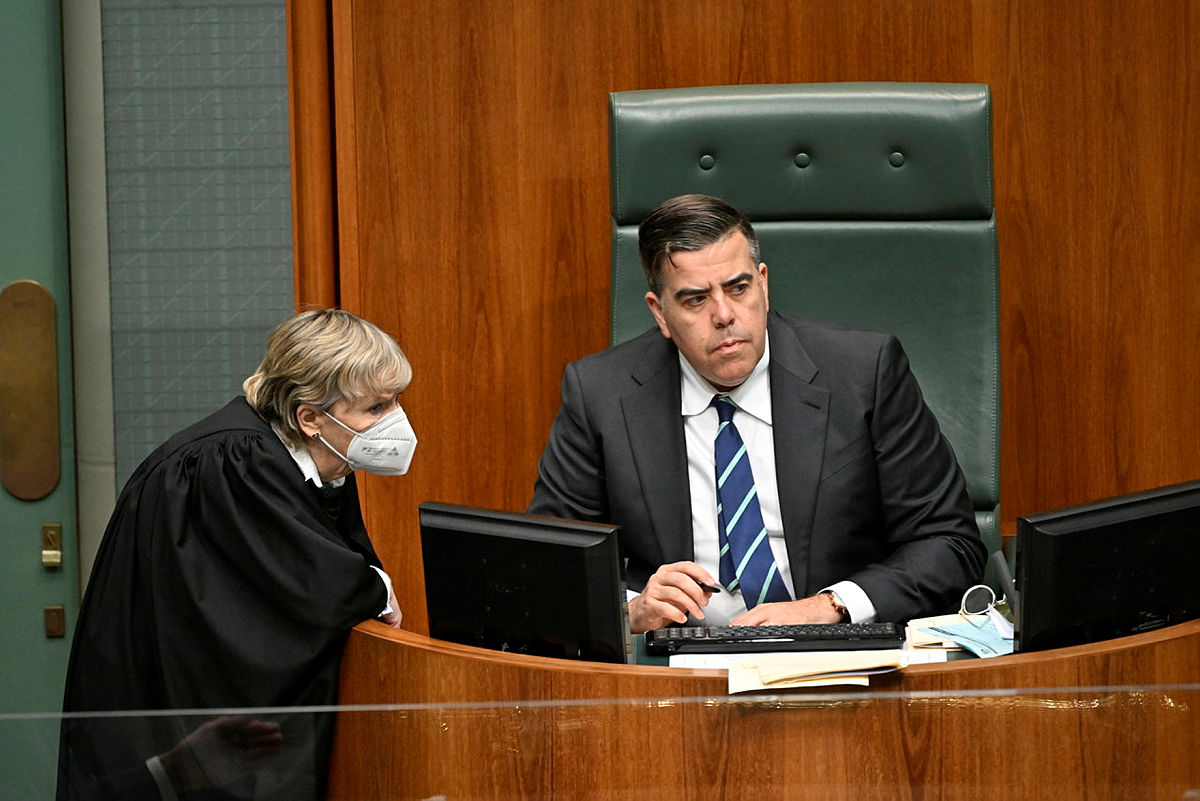What does the House of the Representatives do?
Some of the key activities a Member of the House of Representatives will undertake include:
- Considering, debating, and creating new laws.
- Asking questions about government policy, like at Question Time.
- Keeping the Executive (the Prime Minister and Cabinet) in check.
- Debating and voting on where the government should spend money – only the House of Representatives has the power to do this.
- Joining a committee to explore important topics in depth.
- Raising important community issues or opportunities with other Members of Parliament.
What do Members do outside the Chamber on a typical sitting day?
Except during Question Time and special events, Members will generally only be in the Chamber to participate in a debate.
During sitting days, when Members are not in the Chamber, they will:
- attend meetings
- participate in committees (through public hearings and private meetings)
- respond to correspondence
- prepare speeches
- deal with matters on behalf of their constituents.

Who is the Speaker of the House of Representatives?
The Speaker of the House of Representatives runs the meetings of the House of Representatives and is in charge of making sure the rules of the House are followed.
The Speaker is an elected Member with parliamentary experience and knowledge, and is expected to treat all Members of the House fairly and equally.
The Speaker is chosen by Members of the House. If more than one Member is proposed as Speaker, a secret vote takes place in the House.
Outside of the Chamber, the Speaker is responsible for:
- Receiving special visitors, including members from other parliaments, on behalf of the House.
- Working with the President of the Senate to oversee the management of Parliament House and its immediate surroundings.
- Overall responsibility for the administration of the House of Representatives.
You can learn more about the Speaker and their role through Infosheet 3 - The Speaker.

Who is the Clerk of the House?
The Clerk is the most senior official in the Department of the House of Representatives.
They have extensive knowledge and experience in rules and procedure of the House, and provide advice to the Speaker of the House on procedural matters. They will always sit on the Speaker’s right-hand side.
The Clerk is the only non-elected person to have a speaking role in the proceedings of the House.
The Clerk has an important role in the Chamber during sitting weeks.
They will:
- Provide advice to the Speaker and Members to make sure that the rules (Standing Orders) of the House are being followed
- Keep track of the votes and actions in the House, and
- Certify that a bill has passed through the Parliament.
The Clerk is also the head of the Department of the House of Representatives, and oversees a department of around 170 staff. The Department of the House of Representatives is responsible for supporting the Speaker and Members.
You can learn more about the Clerk and their role through Infosheet 21 - The Clerk and other officials.

Who are the Clerks-at-the-Table?
The Clerk and Deputy Clerk of the House are usually seated at the Table in front of the Speaker on important occasions and usually at Question Time each day.
The Clerks are supported by other senior staff from the Department of the House of Representatives who are rostered to perform the role of the Clerk and Deputy Clerk at certain other times during the day. They are called “Clerks-at-the-Table”.
Who is the Serjeant-at-Arms?
The role of the Serjeant-at-Arms dates back to early British history. Originally, Serjeants-at-Arms were members of the English royal bodyguard. Today, the Serjeant-at-Arms escorts the Speaker of the House of Representatives to and from the Chamber, while carrying the Mace.
The Serjeant-at-Arms is one of the few non-elected persons that work in the Chamber.
The Serjeant-at-Arms has several key ceremonial jobs in the House during sitting weeks. They:
- escort the Speaker to and from the Chamber
- maintain order
- record attendance
- stand guard during a division (vote), and
- deliver formal messages to the Senate.
When not in the House, the Serjeant-at-Arms holds an administrative role in the Department of the House of Representatives. Some of the Serjeant-at-Arms’ responsibilities include:
- corporate services for the department and Members
- security in the House of Representatives within the Parliamentary precincts, and
- managing visitor bookings to the House of Representatives.
You can learn more about the Serjeant-at-Arms and their role through Infosheet 21 - The Clerk and other officials.

Want more information?
The House of Representatives infosheets contain more in-depth information about the workings of the House and the roles of those within it. These are suitable for anyone who wants to know more about how the Parliament works.
The Parliamentary Education Office develop and maintain resources to educate Australians about, and inspire their enthusiasm for Australia’s parliamentary democracy. Check out their resources on their website.
Parliament Explained series
The next article in the Parliament Explained series will dive into the House of Representatives Chamber and the Federation Chamber as well as some their functions.
You can follow our series on our Facebook page and find previous articles here.